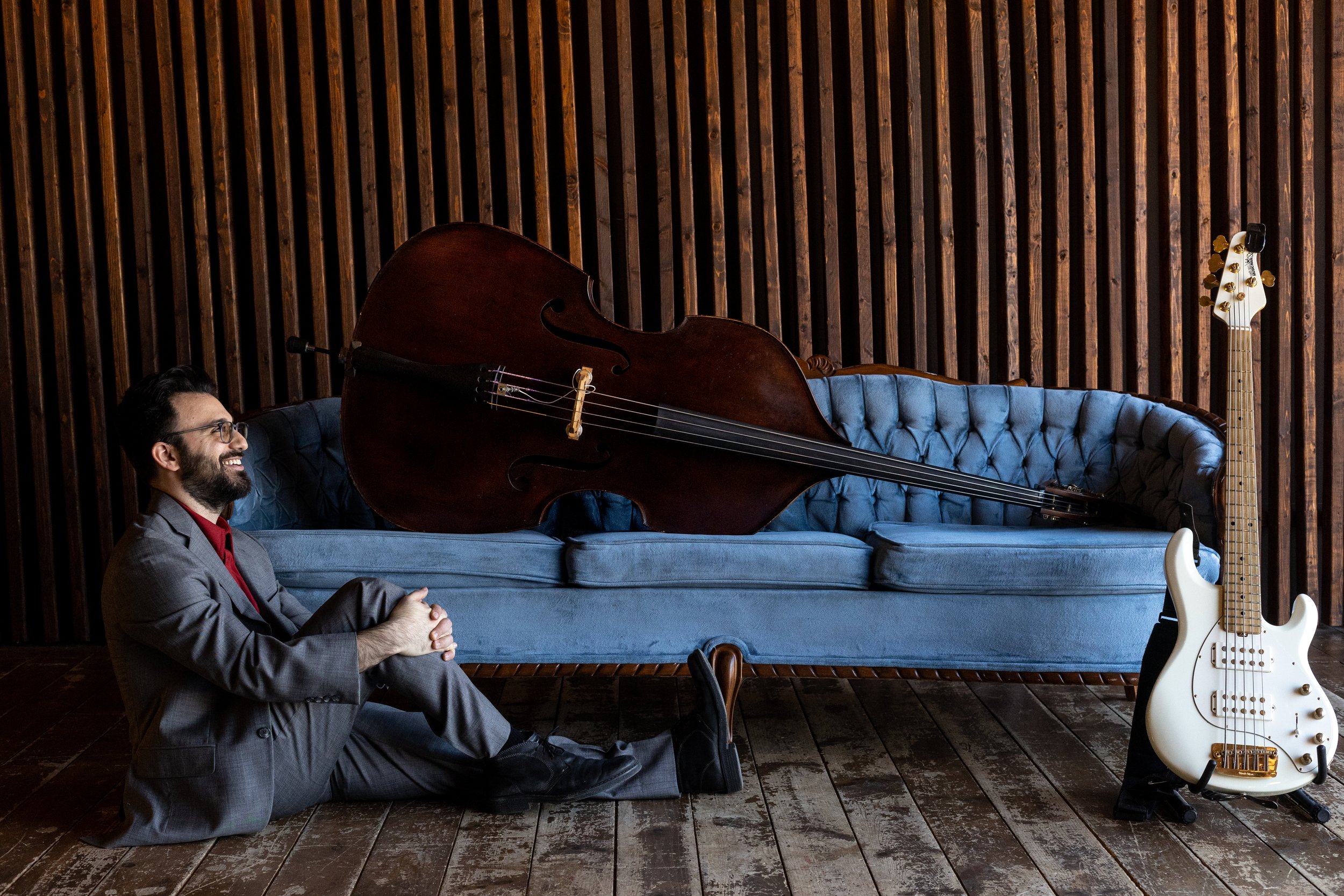
Marty Isenberg’s Wes Anderson Playlist
Opening scene: A young Marty Isenberg takes his dad’s bass off the wall, sits down on a faded green sofa and begins to play. It’s been two years since his father died and waves of grief wash over him. One year later: Cut to a two-car garage turned into a rehearsal space. There’s wood paneling everywhere, a drum set, two guitar amps and a Rage Against the Machine poster on the wall. Marty is in a spectacularly bad goth punk band. They wear black trench coats and pleather pants. They wobble in and out of time, wonky but thriving. Cut to a close-up of Marty sitting on the bottom bunk bed in his bedroom practicing bass, as if it’s some kind of sacred ritual. He looks lonely but focused, deep in the angst of teenagehood. Cut to the present day, Bunker Studios in Brooklyn, Isenberg recording his debut album, The Way I Feel Inside, a mixtape of songs from Wes Anderson films. He has the spark of someone who turned his teenage insecurities into a superpower—much like Wes Andreson’s characters and perhaps like the filmmaker himself. Fade to black. End scene.
“I’ve always resonated deeply with Wes Anderson’s movies,” muses Isenberg. “There was something so familiar about the way he captured the ache of adolescence.” He appreciated how Anderson’s cinematic language always seemed to juxtapose our local vastness with our cosmic tininess. Of course, Isenberg loved the off-kilter mixtape quality of the soundtracks and how perfectly they mirrored the plotlines. So he set out to put his own spin on songs by artists like David Bowie, Nick Drake and the Velvet Underground but through the lexicon of jazz orchestration and improvisation. The resulting album is a sonic storyboard, a soundtrack to the wonder, loneliness and nostalgia of life in the modern world. Downbeat Magazine’s glowing review says that, “Movies for your ears are somewhat cliched, but Isenberg has gone way beyond that. This is a movie.”
The album opens with “Stephanie Says,” a fantasy about an unlived life. The protagonist works in a call center, dogged by the nagging feeling she’s wasting her life. “So Long” is a love song written to someone the singer is choosing to leave. Isenberg dedicated it to his ex and while the lyrics are bittersweet, the arrangement lives on the sunny side of a New Orleans street. The track features devastatingly beautiful vocals by Sami Stevens and a large cast of supporting musicians. The title track, “The Way I Feel Inside,” is an intimate portrait of unrequited love, though Isenberg reads it more as a song about the burning desire to be seen: “Should I try to hide / the way I feel inside.” Before recording the album, he came out as queer and left his marriage after ten years together. The album, like Anderson’s oeuvre as a whole, portrays the way in which acting on the fantasy of a different life leads you from loss to liberation and eventually, acceptance. It’s an arc Isenberg knows intimately. While Andreson’s films are not queer-coded, they were nonetheless a secret decoder ring for his own experience as a newly-divorced, queer jazz musician navigating life in Brooklyn.
After devoting himself wholeheartedly to the bass, Isenberg began taking lessons with Steve Buslowe from the chart-topping 70s band Meatloaf. He later went to New School for composition and earned a masters from NYU, where he wrote for his 13-piece band MIBB. Fascinated with arcane moments in popular music history, he wrote an essay on Disco.
Demolition Night, Major League Baseball’s infamous two-night doubleheader in 1979 between the Chicago White Sox and the Detroit Tigers in which Steve Dahl, an anti-disco, shock-jock radio DJ, invited the crowd to burn disco records during the seventh inning stretch. It resulted in an all-out riot that is said to have precipitated the decline of disco music in the 80s. Isenberg was particularly fascinated by the sudden rise and fall of disco, a music born out of the Black and gay nightclub scene. Why did the rock n’ rollers despise disco so much? Was the backlash actually rooted in racism? Or perhaps homophobia? For Isenberg, these questions were both personal and central to his doctoral research at Stony Brook University.
Isenberg has been an in-demand bassist in the New York City jazz scene for almost 20 years. He’s played Birdland, the Blue Note and the Public Theater as well as several Broadway musicals. He has toured nationally and internationally at venues like Dazzle (Denver), Century Room (Tucson), Skirball Center (Los Angeles) and the El Salvador Jazz Festival. He is the founder and CEO of the Clinton Hill Music School, a twelve-year-old neighborhood music program in Brooklyn. His debut album garnered much critical acclaim and resonated with a wide audience, making the NACC jazz charts and racking up over 40,000 streams on Spotify. Vintage Guitar Magazine described The Way That I Feel as a “fascinating concept, executed splendidly.” Isenberg’s unique sensibility seems to capture the melancholy, wonder and precision of Wes Anderson’s cult classics. Perhaps a sequel is in store. In the meantime, roll credits.
Music Videos
Album Reviews
International Reviews
Media Appearances:
Bass Musician Magazine:
https://bassmusicianmagazine.com/2023/06/new-album-marty-isenberg-the-way-i-feel-inside/
Bass Magazine:
https://bassmagazine.com/artists/bassist-marty-isenberg-announces-new-album-the-way-i-feel-inside
No Treble Magazine:
https://www.notreble.com/buzz/2023/07/13/the-way-i-feel-inside-an-interview-with-marty-isenberg/
Neon Jazz:
https://www.youtube.com/watch?v=s1ZXkLUmKPE
Vinyl District Radar:
From and Inspired By:
http://www.fromandinspiredby.com/blog/2023/7/13/episode-143-marty-isenberg
The Bass Shed Podcast:
https://open.spotify.com/episode/2qazohAqW0tuGx4dZmo5YT?si=00b379f9e0f24ee2
Contrabass Conversations:
Radio Play
Radio Play
Debuted on NACC jazz top 30!
18 weeks on Jazz Week’s top 200!





















